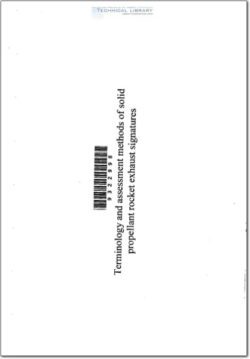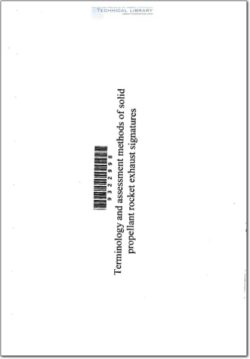AGARD-AR-287

- Version
- 232 Downloads
- 16.43 MB File Size
- 1 File Count
- March 8, 2016 Create Date
- March 8, 2016 Last Updated
Terminology and Assessment Methods of Solid Propellant Rocket Exhaust Signatures

It is the working group‘s intention that this
overview should provide a useful background
framework for understanding the specific
technical chapters and recommendations that
follow in the remainder of this AGARD Advisory
Report.
Exhaust plumes have been a concern in
rocket propulsion technology for over four
decades. The early concerns involved plume inter-
ference with microwave guidance signals for
beam-rider and semi-active systems. Subsequent
concerns involved exhaust detectability due to
primary and secondary smoke and the effects of
smoke on some kinds of missile optical guidance
systems. The recent emergence of autonomous
electro—optical detection and tracking systems has
introduced strong concern about increased missile
and launch-platform vulnerability due to the
entire spectrum of exhaust plume emissions. This
becomes even more important as other missile
signatures, such as body emissions, body
scattering, and body radar cross section (RCS),
are reduced by application of new materials
technology and non—axisymmetric geometry [1].
Overriding all exhaust plume measurements
and predictions is a requirement to quantitatively
specify required signature levels for' current
and future missile missions. Straightforward as
this sounds, it has never been adequately done
for any tactical missile plume. There is no
question that it should be done to set realistic
goals and to prioritize research and development
(R&D) efforts for plume detection, identification,
tracking, targeting, and control. In addition,
required signature levels must be identified with
specific operational time—frames to correlate with
projected enemy detection capabilities. It is also
critical that signature be scored or ranked as to
its value for any mission, also the relative value of
each type of signature for that mission (e.g., IR,
UV, smoke, flash, RCS). Other plume effects (e.g.
guidance interference and plume impingement
effects) are performance issues that must be
solved for deployment. Once a set of prioritized
signature goals has been established, it may be
possible to prioritize the Research and
Development required to reach the goals.
| File | Action |
|---|---|
| AGARD-AR-287 Terminology and Assessment Methods of Solid Propellant Rocket Exhaust Signatures.pdf | Download |
Comment On This Post